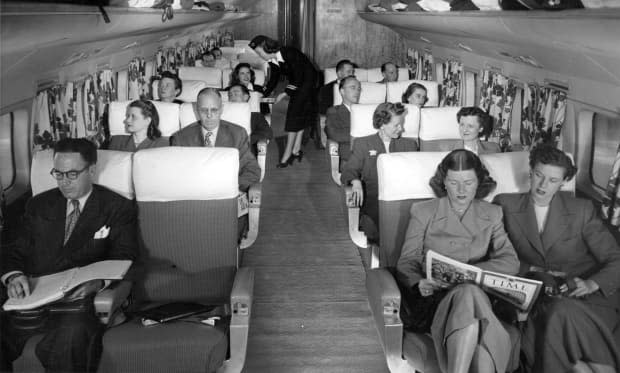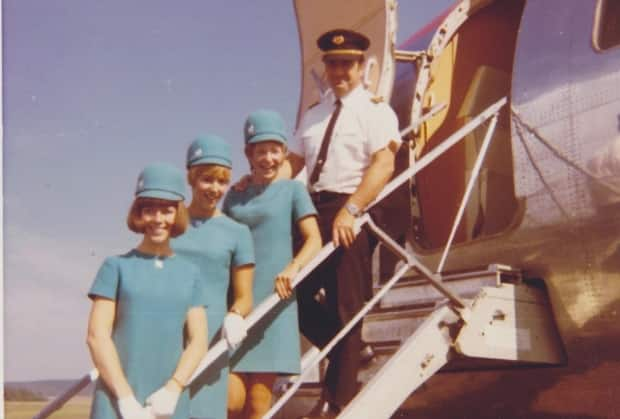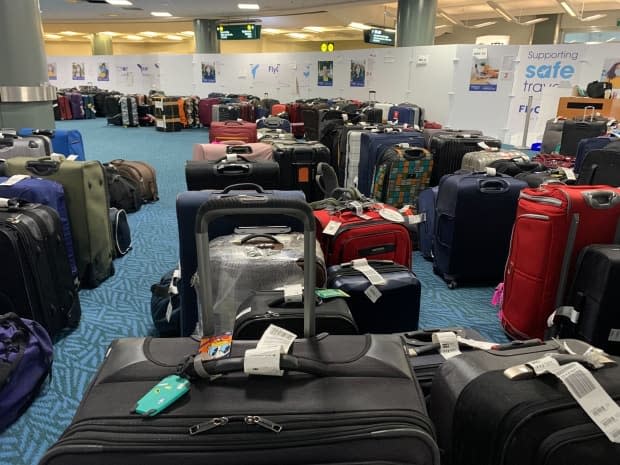Business
Why the golden age of flying is never coming back — and it might not be a bad thing
|
|

From pricey parking to pat downs at security and long lineups everywhere you turn, air travel these days can be unpleasant.
“I get on a plane now at least once a month and to me, it’s like riding on a bus in the sky. Herd me on, sit me down, get me off. They’ve taken away the lure of the travel,” said Susan Barnes, 75, of Halfmoon Bay, B.C., who has been a frequent flyer for more than half a century.
Barnes, who was a flight attendant in the 1960s and ’70s, says she remembers when flying was like a Mad Men cocktail party in the sky. She jetted around the globe pouring free champagne for passengers flying CP Air, a carrier that operated until 1986 when it was taken over by Pacific Western Airlines (PWA) and then, Canadian Airlines.
Barnes said her job was to provide top notch treatment to every passenger, even those sitting in economy. That meant handing out hot towels before and after every meal. Breakfast, lunch and dinner were served on real china, with silverware and cloth napkins — then out came coffee, tea and a fruit basket.


“We were treating these people as if they were in a first-class establishment. We just happened to be in the air,” Barnes said.
Barnes and other retired CP Air, Canadian and Air Canada flight attendants interviewed by the Cost of Living described flying back then as “a pleasure.”
It’s a far cry from the experience thousands of Canadians had with airlines this past holiday season. Staff shortages, weather issues and computer outages resulted in lost baggage, cancelled flights and stranded passengers who are now battling air carriers for compensation.
This, along with a summer of major travel disruptions due to COVID-19 labour shortages, has the federal government promising to overhaul Canada’s airline passenger bill of rights.
If you’ve been caught in that tangled web of travel chaos, you may be asking yourself what happened. Experts say it comes down to costs, and competition — and that we’re unlikely to ever return to that golden age of flying.
Keeping prices competitive meant airlines had to be more ruthless about the bottom line, said Fred Lazar, an associate professor of economics at York University.
“Here’s a fare, it gets you a seat from A to B. Anything else costs more.”
Carrier competition
What most Canadians remember as the golden age of flying was the era when commercial aviation was regulated, explained Lazar. It was a time when airlines didn’t have to cut costs to stay competitive, because the federal government didn’t allow them to compete with one another.
“So it was essentially the government saying this is where you can fly, when you can fly and these are the prices.”
Up until 1986, the two big players were private carrier CP Air and government-owned Air Canada (formerly Trans-Canada Airlines), said Lazar, and the government did not allow much overlap on routes.
In the absence of competition, experts say Canadian carriers were guaranteed to attract customers and make money, which meant they could afford to offer perks on their flights to passengers.
According to Julie LeBlond Parker, who started as a flight attendant for CP Air in 1968, airlines also invested in their staff. She received extensive training in “decorum” and “finesse” before taking to the sky.
“The service was based on old European service. It was a very high standard,” said LeBlond Parker, who now lives in South Surrey, B.C.
Domestic and international flight prices, 1959 vs. 2023
But the golden age of air travel was also out of reach for many Canadians. Fare schedules from collectors and the archives of the Canada Aviation and Space Museum reveal that throughout the 1940s, ’50s and ’60s, flying was incredibly expensive.
In 1950, a return flight on Trans-Canada Airlines from Vancouver to Johannesburg, South Africa, cost over $21,000 when adjusted for inflation. Flying Toronto to Vancouver in 1962 on CP Air was roughly $1,900.
With prices like that, LeBlond Parker, said the regulars on her flights were business travellers, not vacationers. Leisure travellers were usually newlyweds, couples and families embarking on a once-in-a-lifetime trip.
“What was really amazing about it is that they all dressed up. They probably got a new outfit just to fly because it was special. It was a very special thing.”


Goodbye blankets, hello bargains
Barry Prentice, the director of the Transport Institute at the University of Manitoba, said Canadians saw a “tremendous drop” in airfares south of the border when the U.S. deregulated its airlines in 1978.
“They went from $700 to $200, or something. And everybody in Canada was sitting there, you know, wondering, ‘well, why don’t we have that?’
Prentice said the Canadian government followed the U.S., loosening its grip on the airline industry throughout the 1980s and ’90s. During that time, Air Canada became privatized and more carriers entered the Canadian market. As competition ramped up, airfares went down.
But that’s not the only reason flying became cheaper, explained Prentice.
Advances in aviation technology meant planes became more fuel efficient and larger, which increased air cargo and passenger capacity. Prentice said that — along with the 1980s oil glut, brought down the price per seat.
Even when crude prices rebounded, legacy airlines like Air Canada couldn’t go back to charging passengers as much for flights as they did before deregulation because they were up against the à la carte pricing model of no-frills carriers, said Lazar.


“Many people said, ‘We didn’t have to pay for bags, we got food for free, we didn’t have to pay for earphones,” Lazar said.
“Well now, in the lowest-fare categories, you do, because the airlines want to compete with the ultra low-cost carriers. And that’s the only way they can do it.”
Lazar, who has also worked as a consultant for Qantas, Air Canada and Porter Airlines, said stripping away the luxuries and packing more seats on planes is a “major contributing factor to making flying in economy much less comfortable and attractive, yet much more affordable.”
Snafus at security
While Canadians often blame airlines for a lousy flying experience, chaos at airport security and gates can also contribute to the overall unpleasantness of air travel. Experts say that’s because airports aren’t designed for the realities of today’s travel.
Between 1973 and 2008, Anthony Wade-Cooper was a flight attendant for CP Air, Canadian and Air Canada. He says before 9/11, he could make it from the check-in counter to the gate in 20 minutes.
“It was just so different. You just walked into the airport and you got on a flight,” he said Wade-Cooper, who is now retired in a town called Mooloolaba on Australia’s Sunshine Coast.
Nowadays, airlines ask passengers flying domestic to arrive at the airport two hours in advance and Wade-Cooper said he often spends most of that time standing in a queue.


Security snafus are also a result of a steady increase in air travel over the last decade — peaking in 2019 with nearly 163 million passengers passing through Canadian airports, according to Statistics Canada.
According to Lazar, most airports were not built for a post-9/11 world where every traveller has to take off their belt and shoes. There are also design problems when passengers arrive at gates. Lazar says some airports are designed like malls — a lot of shops and restaurants but not a lot of seating.
“There’s no place to sit. You know, if you have long delays, where are you going to go?”
But what we get in exchange for fewer perks and busier airports, said Prentice, are cheaper flights — and that means more people than ever can afford to fly. Which he thinks is a “really good thing.”
“More families can travel and, over time, families have split up wider and wider. My grandchildren are in Montreal and I’m in Winnipeg and I wouldn’t see them very often if it weren’t for air travel.”
If you’re wondering if there’s a way to get back a bit of the elegance or at least the enjoyment of flying, Lazar said you can’t expect to pay rock bottom prices.
He said the only way back to the golden age of travel is to fly first class or rent a private jet.
“Otherwise, just accept the fact that air travel is really the same as travelling on a bus. Except it gets you from A to B much more quickly.”







Business
Gildan replacing five directors ahead of AGM, will back two Browning West nominees
|
|
MONTREAL — Gildan Activewear Inc. is making changes to its board of directors in an attempt to head off a move by an activist shareholder looking to replace a majority of the board at its annual meeting next month.
U.S. investment firm Browning West wants to replace eight of Gildan’s 12 directors with its own nominees in a move to bring back founder Glenn Chamandy as chief executive.
Gildan, which announced late last year that Chamandy would be replaced by Vince Tyra, said Monday it will replace five members of its board of directors ahead of its annual meeting set for May 28.
It also says current board members Luc Jobin and Chris Shackelton will not run for re-election and that it will recommend shareholders vote for Karen Stuckey and J.P. Towner, who are two of Browning West’s eight nominees.
The new directors who will join the Gildan board on May 1 are Tim Hodgson, Lee Bird, Jane Craighead, Lynn Loewen and Les Viner. They will replace Donald Berg, Maryse Bertrand, Shirley Cunningham, Charles Herington and Craig Leavitt.
Hodgson, who served as chief executive of Goldman Sachs Canada from 2005 to 2010, is expected to replace Berg as chair.
“I look forward to working with this highly qualified board and management team to realize the full benefits of Vince’s ambitious yet realistic plan to drive growth by enhancing the Gildan sustainable growth strategy,” Hodgson said in a statement.
“The refreshed board and I fully believe in Vince and his talented team as well as Gildan’s leading market position and growth prospects.”
Gildan has been embroiled in controversy ever since it announced Chamandy was being replaced by Tyra.
The company has said Chamandy had no credible long-term strategy and had lost the board’s confidence. But several of Gildan’s investors have criticized the company for the move and called for his return.
Those investors include the company’s largest shareholder, Jarislowsky Fraser, as well as Browning West and Turtle Creek Asset Management.
In announcing the board changes, Gildan said it met with shareholders including those who Browning West has counted as supportive.
“Our slate strikes a balance between ensuring the board retains historical continuity during a period of transition and provides fresh perspectives to ensure it continues to serve its important oversight function on behalf of all shareholders,” the company said.
Gildan said last month that it has formed a special committee of independent directors to consider a “non-binding expression of interest” from an unnamed potential purchaser and contact other potential bidders.
But Browning West and Turtle Creek have said the current board cannot be trusted to oversee a sale of the company.
The company said Monday that there continues to be external interest in acquiring the company and the process is ongoing.
This report by The Canadian Press was first published April 22, 2024.
Companies in this story: (TSX:GIL)
The Canadian Press





Business
Ottawa puts up $50M in federal budget to hedge against job-stealing AI – CP24


Anja Karadeglija, The Canadian Press
Published Sunday, April 21, 2024 4:02PM EDT
Last Updated Sunday, April 21, 2024 4:04PM EDT
Worried artificial intelligence is coming for your job? So is the federal government — enough, at least, to set aside $50 million for skills retraining for workers.
One of the centrepiece promises in the federal budget released Tuesday was $2.3 billion in investments aiming to boost adoption of the technology and the artificial intelligence industry in Canada.
But tucked alongside that was a promise to invest $50 million over four years “to support workers who may be impacted by AI.” Workers in “potentially disrupted sectors and communities” will receive new skills training through the Sectoral Workforce Solutions Program.
“There is a significant transformation of the economy and society on the horizon around artificial intelligence,” said Joel Blit, an associate professor of economics at the University of Waterloo.
Some jobs will be lost, others will be created, “but there’s going to be a transition period that could be somewhat chaotic.”
While jokes about robots coming to take jobs predate the emergence of generative AI systems in late 2022, the widespread availability of systems like ChatGPT made those fears real for many, even as workers across industries began integrating the technology into their workday.
In June 2023, a briefing note for Finance Minister Chrystia Freeland warned the impact of generative AI “will be felt across all industries and around 40 per cent of all working hours could be impacted.”
“Banking, insurance and energy appear to have higher potential for automation compared to other sectors,” says the note, obtained through access to information and citing information from Accenture.
“This could have substantial impacts on jobs and skills requirements.”
The budget only singles out “creative industries” as an affected sector that will be covered by the program. In February, the Canadian TV, film, and music industries asked MPs for protection against AI, saying the tech threatens their livelihood and reputations.
Finance Canada did not respond to questions asking what other sectors or types of jobs would be covered under the program.
“The creative industries was used as an illustrative example, and not intended as an exclusion of other affected areas,” deputy Finance spokesperson Caroline Thériault said in a statement.
In an interview earlier this year, Bea Bruske, president of the Canadian Labour Congress, said unions representing actors and directors have been very worried about how their likenesses or their work could be used by AI systems. But the “reality is that we have to look at the implication of AI in all jobs,” she said.
Blit explained large language models and other generative AI can write, come up with new ideas and then test those ideas, analyze data, as well as generate computer programming code, music, images, and video.
Those set to be affected are individuals in white-collar professions, like people working in marketing, health care, law and accounting.
In the longer run, “it’s actually quite hard to predict who is going to be impacted,” he said. “What’s going to happen is that entire industries, entire processes are going to be reimagined around this new technology.”
AI is an issue “across sectors, but certainly clerical and customer service jobs are more vulnerable,” Hugh Pouliot, a spokesperson for the Canadian Union of Public Employees, said in an email.
The federal government has used AI in nearly 300 projects and initiatives, new research published earlier this month revealed.
According to Viet Vu, manager of economic research at Toronto Metropolitan University’s the Dais, the impact of AI on workers in a sector like the creative industry doesn’t have to be negative.
“That’s only the case if you adopt it irresponsibly,” he said, pointing out creative professionals have been adopting new digital tools in their work for years.
He noted only four per cent of Canadian businesses are using any kind of artificial intelligence or machine learning. “And so we’re really not there yet for these frontier models and frontier technologies” to be making an impact.
When it comes to the question of how AI will affect the labour market, it’s more useful to think about what types of tasks technology can do better, as opposed to whether it will replace entire jobs, Vu said.
“A job is composed of so many different tasks that sometimes even if a new technology comes along and 20, 30 per cent of your job can be done using AI, you still have that 60, 70 per cent left,” he said.
“So it’s rare that (an) entire occupation is actually sort of erased out of existence because of technology.”
Finance Canada also did not respond to questions about what new skills the workers would be learning.
Vu said there are two types of skills it makes sense to focus on in retraining — computational thinking, or understanding how computers operate and make decisions, and skills dealing with data.
There is no AI system in the world that does not use data, he said. “And so being able to actually understand how data is curated, how data is used, even some basic data analytics skills, will go a really long way.”
But given the scope of the change the AI technology is set to trigger, critics say a lot more than $50 million will be necessary.
Blit said the money is a good first step but won’t be “close to enough” when it comes to the scale of the coming transformation, which will be comparable to globalization or the adoption of computers.
Valerio De Stefano, Canada research chair in innovation law and society at York University, agreed more resources will be necessary.
“Jobs may be reduced to an extent that reskilling may be insufficient,” and the government should look at “forms of unconditional income support such as basic income,” he said.
The government should also consider demanding AI companies “contribute directly to pay for any social initiative that takes care of people who lose their jobs to technology” and asking “employers who reduce payrolls and increase profits thanks to AI to do the same.”
“Otherwise, society will end up subsidizing tech businesses and other companies as they increase profit without giving back enough for technology to benefit us all.”
Business
Honda to build electric vehicles and battery plant in Ontario, sources say – Global News
Honda Canada is set to build an electric vehicle battery plant near its auto manufacturing facility in Alliston, Ont., where it also plans to produce fully electric vehicles, The Canadian Press has learned.
Senior sources with information on the project confirmed the federal and Ontario governments will make the announcement this week, but were not yet able to give any dollar figures.
However, comments Monday from Ontario Premier Doug Ford and Economic Development Minister Vic Fedeli suggest it is a project worth around $14 billion or $15 billion.
Ford told a First Nations conference that there will be an announcement this week about a new deal he said will be double the size of a Volkswagen deal announced last year. That EV battery plant set to be built in St. Thomas, Ont., comes with a $7-billion capital price tag.
Fedeli would not confirm if Ford was referencing Honda, but spoke coyly after question period Monday about the amount of electric vehicle investment in the province.
“We went from zero to $28 billion in three years and if the premier, if his comments are correct, then next week, we’ll be announcing $43 billion … in and around there,” he said.
More on Canada
The Honda facility will be the third electric vehicle battery plant in Ontario, following in the footsteps of Volkswagen and a Stellantis LG plant in Windsor, and while those two deals involved billions of dollars in production subsidies as a way of competing with the United States’ Inflation Reduction Act subsidies, Honda’s is expected to involve capital commitments and tax credits.
Federal Finance Minister Chrystia Freeland’s recent budget announced a 10-per-cent Electric Vehicle Supply Chain investment tax credit on the cost of buildings related to EV production as long as the business invests in assembly, battery production and cathode active material production in Canada.
That’s on top of an existing 30-per-cent Clean Technology Manufacturing investment tax credit on the cost of investments in new machinery and equipment.
Honda’s deal also involves two key parts suppliers for their batteries — cathodes and separators — with the locations of those facilities elsewhere in Ontario set to be announced at a later date.
The deal comes after years of meetings and discussions between Honda executives and the Ontario government, the sources said.
Prime Minister Justin Trudeau, Premier Doug Ford and Honda executives were on hand in March 2022 in Alliston when the Japanese automaker announced hybrid production at the facility, with $131.6 million in assistance from each of the two levels of government.
Around the time of that announcement, conversations began about a larger potential investment into electric vehicles, the sources said, and negotiations began that summer.
Fedeli travelled to Japan that fall, the first of three visits to meet with Honda Motor executives about the project. Senior officials from the company in Japan also travelled to Toronto three times to meet with government officials, including twice with Ford.
During a trip by the Honda executives to Toronto in March 2023, Ontario officials including Fedeli pitched the province as a prime destination for electric vehicle and battery investments, part of a strong push from the government to make Ford’s vision of an end-to-end electric vehicle supply chain in the province a reality.
Negotiations took a major step forward that July, when Ontario sent a formal letter to Honda Canada, signalling its willingness to offer incentives for a battery plant and EV production. Honda Canada executives then met with Ford in November and December.
The latter meeting sealed the deal, the sources said.
Honda approached the federal government a few months ago, a senior government official said, and Freeland led her government’s negotiations with the company.
The project is expected to involve the construction of several plants, according to the source.
— With files from Nojoud Al Mallees in Ottawa.
© 2024 The Canadian Press
-



 Health5 hours ago
Health5 hours agoRemnants of bird flu virus found in pasteurized milk, FDA says
-
Art11 hours ago
Mayor's youth advisory council seeks submissions for art gala – SooToday
-
News17 hours ago
Some Canadians will be digging out of 25+ cm of snow by Friday – The Weather Network
-



 Science19 hours ago
Science19 hours ago"Hi, It's Me": NASA's Voyager 1 Phones Home From 15 Billion Miles Away – NDTV
-
Media16 hours ago
Jon Stewart Slams the Media for Coverage of Trump Trial – The New York Times
-
Art23 hours ago
Made Right Here: Woodworking art – CTV News Kitchener
-



 Health9 hours ago
Health9 hours agoBird flu virus found in grocery milk as officials say supply still safe
-



 Investment10 hours ago
Investment10 hours agoTaxes should not wag the tail of the investment dog, but that’s what Trudeau wants







